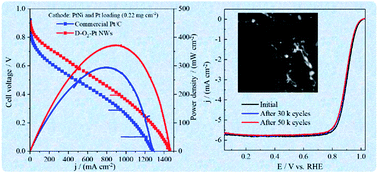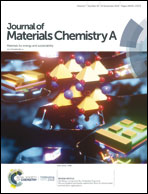Highly stable one-dimensional Pt nanowires with modulated structural disorder towards the oxygen reduction reaction†
Abstract
Developing stable nanocatalysts with high activity for the oxygen reduction reaction (ORR) remains a great challenge in the field of clean energy. Herein, a highly stable and active nanocatalyst is designed by an efficient dealloying of Pt–Ni nanowires in an oxygen saturated solution. It is found that Ni atoms can be removed almost completely in an oxygen atmosphere (D-O2–Pt NWs) instead of an Ar environment, confirmed by a combination of X-ray diffraction, X-ray photoelectron spectroscopy and surface-sensitive electrochemical characterization methods. As a result, the D-O2–Pt NWs exhibit an enhanced mass (0.86 A mgPt−1) and specific (0.99 mA cmPt−2) activity compared to commercial Pt/C for the ORR by a factor of 5 and 5.8, respectively. These catalysts also show an increased power density (30%) and polarization current density (50%) at 0.5 V of real H2/air PEMFCs with respect to commercial Pt/C. In addition, in contrast to the 60% activity loss of Pt/C after accelerated degradation tests (ADTs) for 50 000 potential cycles, the D-O2–Pt NWs show an extremely stable behavior with only 17% performance loss. The high activity and extreme stability of D-O2–Pt NWs are rationalized by the structural effects, confirmed by the combination of quantitative analysis using X-ray absorption fine structure (XAFS), high resolution-transmission electron microscopy (HR-TEM) and average adsorbed CO oxidation potential (μCO1). This work illustrates a new class of Pt based nanocatalysts with high activity and stability for the ORR.

- This article is part of the themed collection: 2019 Journal of Materials Chemistry A HOT Papers


 Please wait while we load your content...
Please wait while we load your content...